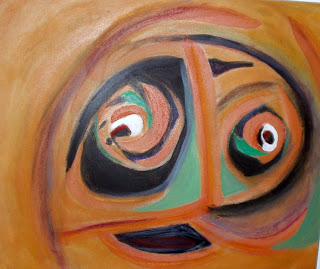Before Western psychiatrists managed to create a huge volume of detailed diagnoses (DMS IV-R), the mental or emotionalillnesses or "disoerders" of artists and everyone else simply persisted without label and denied recognition and often treatment, unless for obvious maladies like schizophrenia, although these unfortunates were merely shunted off to squalid dungeons for the insane.
I painted these acryclic on canvass inner demons inspired by noone but my subconscious.
 |
| Acrylic on canvass by S. van Drake 34 X 24 cm |
I do not understand them and as I said, I don't like them.
Many assert Van Gogh was bi-polar or manic-depressive. So what? What is unusual about a third of all professional actors in the US diagnosed bi-polar?
Most cope well with the disorder and some thrive from it. Van Gogh experienced extreme mood swings and energy levels consistent with modern day bi-polar symptoms.
Remember, no one-size label fits all.
You might ascribeVan Gogh's cutting off his ear to his mental disease or disorder but it's more likely a result of a ferocious argument and falling out with Paul Gauguin, his estranged studio mate in the south of France.
"Now if I recover, I must start afresh, but I shall never be able to reach the heights to which the illness to some extent had me," Van Gogh wrote Gauguin on 12 January 1889.
I personally identify with Van Gogh's creative thesis about suffering and illness.
Francisco de Goya y Lucientes, after painting The Third of May: Executions in the Moncloa (1808-1814), slid into apparent depression, bitterness and great grief and then, out of the depths of this darkness, created what are known as his Black Paintings, 14 oil paintings on plaster, on show as part of the Prado's permanent collection.
I identify with this creative process that at times motivates many artists--a high level of emotions.
When I first started painting certain events and stressors played an import role in producing a series of what I consider rather bizarre paintings.
I really don't like them.
But a far more experienced artist told me, "They are all self-portraits." The subconscious controls many brush strokes; they are compelling, impulsive and often very dark.
Rock on and practice peace. Check out ArtTraveler's videos at: http://bit.ly/h1vruw
Stefan, the ArtTraveler(TM)




No comments:
Post a Comment